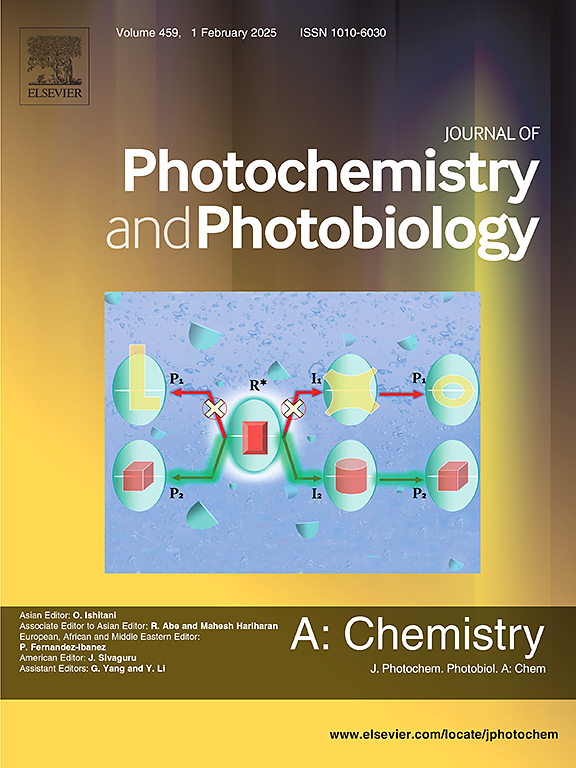Sonoluminescence spectroscopic analysis of samarium(II) in a colloidal suspension
IF 4.7
3区 化学
Q2 CHEMISTRY, PHYSICAL
Journal of Photochemistry and Photobiology A-chemistry
Pub Date : 2025-06-26
DOI:10.1016/j.jphotochem.2025.116598
引用次数: 0
Abstract
Colloidal suspensions of samarium(II)-containing nanoparticles with a size of up to 50 nm were prepared by multibubble ultrasonic dispersion of SmCl2·0.5H2O crystal powder with different contents in dodecane. During moving single-bubble sonolysis of these suspensions, a narrow band with a maximum at 704 nm, appeared in their luminescence spectra, against the broad structureless luminescence band (continuum), typical of most liquid–bubble systems. The recorded sonoluminescence band coincides in the position with the luminescence band of the Sm2+ ion in samarium chloride crystals, or in a suspension of samarium nanoparticles in dodecane. The appearance of the characteristic Sm2+ sonoluminescence band in the ultrasonic luminescence spectrum is caused by the entry of samarium salt nanoparticles into the moving (and thus deformed) bubble, which occurs by the known mechanism of injection of a liquid containing small nanoparticles through the deformed boundary of the gas cavity, and by the collisional electronic excitation of Sm2+ ions followed by emission of light in the bubble plasma, which periodically appears during the ultrasonic vibrations. The dependence of the maximum intensity of the Sm2+ band on the initial amount of dispersed samarium(II) salt was plotted, which can be used to determine Sm(II) on the basis of characteristic sonoluminescence intensity.
胶体悬浮液中钐的声致发光光谱分析
采用不同含量的SmCl2·0.5H2O晶体粉末在十二烷中进行多泡超声分散,制备了粒径达50 nm的含钐纳米颗粒胶体悬浮液。在这些悬浮液的移动单泡声溶过程中,它们的发光光谱出现了一个窄带,最大波长为704 nm,而大多数液体-气泡系统的典型特征是宽的无结构发光带(连续体)。所记录的声致发光带与氯化钐晶体或十二烷中纳米钐悬浮液中Sm2+离子的发光带位置重合。在超声发光光谱中出现特征的Sm2+声致发光带是由于钐盐纳米粒子进入运动(从而变形)的气泡,其发生机制是通过气体腔的变形边界注入含有小纳米粒子的液体,以及Sm2+离子的碰撞电子激发随后在气泡等离子体中发射光。周期性地出现在超声波振动中。绘制了Sm2+带的最大强度与分散钐(II)盐初始量的关系图,可以根据特征声致发光强度来确定Sm(II)。
本文章由计算机程序翻译,如有差异,请以英文原文为准。
求助全文
约1分钟内获得全文
求助全文
来源期刊
CiteScore
7.90
自引率
7.00%
发文量
580
审稿时长
48 days
期刊介绍:
JPPA publishes the results of fundamental studies on all aspects of chemical phenomena induced by interactions between light and molecules/matter of all kinds.
All systems capable of being described at the molecular or integrated multimolecular level are appropriate for the journal. This includes all molecular chemical species as well as biomolecular, supramolecular, polymer and other macromolecular systems, as well as solid state photochemistry. In addition, the journal publishes studies of semiconductor and other photoactive organic and inorganic materials, photocatalysis (organic, inorganic, supramolecular and superconductor).
The scope includes condensed and gas phase photochemistry, as well as synchrotron radiation chemistry. A broad range of processes and techniques in photochemistry are covered such as light induced energy, electron and proton transfer; nonlinear photochemical behavior; mechanistic investigation of photochemical reactions and identification of the products of photochemical reactions; quantum yield determinations and measurements of rate constants for primary and secondary photochemical processes; steady-state and time-resolved emission, ultrafast spectroscopic methods, single molecule spectroscopy, time resolved X-ray diffraction, luminescence microscopy, and scattering spectroscopy applied to photochemistry. Papers in emerging and applied areas such as luminescent sensors, electroluminescence, solar energy conversion, atmospheric photochemistry, environmental remediation, and related photocatalytic chemistry are also welcome.

 求助内容:
求助内容: 应助结果提醒方式:
应助结果提醒方式:


